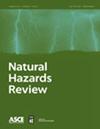Expanding Vulnerability Indices for Pandemic Effects
IF 2.2
3区 工程技术
Q3 ENGINEERING, CIVIL
引用次数: 0
Abstract
In this study, our goal is to identify potentially vulnerable communities that could be subject to ongoing or compounding impacts from the pandemic and/or that may experience a slower recovery due to sociodemographic factors. For this purpose, we compiled information from multiple databases related to sociodemographic and health variables. We used a ranking-based method to integrate them and develop new combined indices. We also investigated a time-dependent correlation between vulnerability components and COVID-19 statistics to understand their time-dependent relationship. We ultimately developed pandemic vulnerability indices by combining CDC's social vulnerability index, our newly developed composite health vulnerability index, and COVID-19 impact indices. We also considered additional assessments include expected annual loss due to natural hazards and community resilience. Potential hot spots (at the county level) were identified throughout the United States, and some general trends were noted. Counties with high COVID-19 impact indices and higher values of the pandemic vulnerability indices were primarily located in the southern United States or coastal areas in the Eastern and Southwestern United States at the beginning of the COVID-19 pandemic. Over time, the computed pandemic vulnerability indices shifted to higher values for counties in the southern and north-central United States, while values calculated for the northwestern and northeastern communities tended to decrease.扩大流行病影响脆弱性指数
在这项研究中,我们的目标是确定可能受到流行病持续或复合影响和/或由于社会人口因素可能经历较慢恢复的潜在脆弱社区。为此,我们从与社会人口和健康变量相关的多个数据库中收集了信息。我们采用基于排名的方法对它们进行整合,形成新的组合指标。我们还研究了漏洞成分与COVID-19统计数据之间的时间依赖相关性,以了解它们的时间依赖关系。最终,我们将CDC的社会脆弱性指数、我们新开发的综合健康脆弱性指数和COVID-19影响指数相结合,制定了大流行脆弱性指数。我们还考虑了额外的评估,包括自然灾害和社区恢复能力造成的预期年度损失。在美国各地确定了潜在的热点(在县一级),并注意到一些一般趋势。COVID-19影响指数和大流行脆弱性指数较高的县主要位于美国南部或美国东部和西南部沿海地区。随着时间的推移,计算出的大流行脆弱性指数在美国南部和中北部的县转向较高的值,而在西北部和东北部社区的计算值则趋于下降。
本文章由计算机程序翻译,如有差异,请以英文原文为准。
求助全文
约1分钟内获得全文
求助全文
来源期刊

Natural Hazards Review
ENGINEERING, CIVIL-GEOSCIENCES, MULTIDISCIPLINARY
CiteScore
4.90
自引率
7.40%
发文量
72
审稿时长
3 months
期刊介绍:
The Natural Hazards Review addresses the range of events, processes, and consequences that occur when natural hazards interact with the physical, social, economic, and engineered dimensions of communities and the people who live, work, and play in them. As these conditions interact and change, the impact on human communities increases in size, scale, and scope. Such interactions necessarily need to be analyzed from an interdisciplinary perspective that includes both social and technical measures. For decision makers, the risk presents the challenge of managing known hazards, but unknown consequences in time of occurrence, scale of impact, and level of disruption in actual communities with limited resources. The journal is dedicated to bringing together the physical, social, and behavioral sciences; engineering; and the regulatory and policy environments to provide a forum for cutting edge, holistic, and cross-disciplinary approaches to anticipating risk, loss, and cost reduction from natural hazards. The journal welcomes rigorous research on the intersection between social and technical systems that advances concepts of resilience within lifeline and infrastructure systems and the organizations that manage them for all hazards. It offers a professional forum for researchers and practitioners working together to publish the results of truly interdisciplinary and partnered approaches to the anticipation of risk, loss reduction, and community resilience. Engineering topics covered include the characterization of hazard forces and the planning, design, construction, maintenance, performance, and use of structures in the physical environment. Social and behavioral sciences topics include analysis of the impact of hazards on communities and the organizations that seek to mitigate and manage response to hazards.
 求助内容:
求助内容: 应助结果提醒方式:
应助结果提醒方式:


